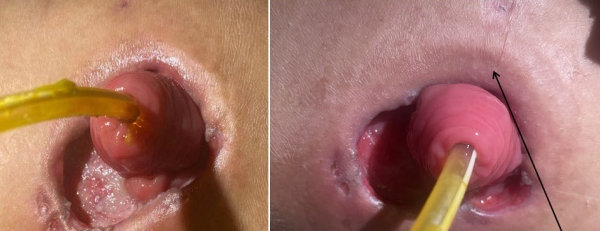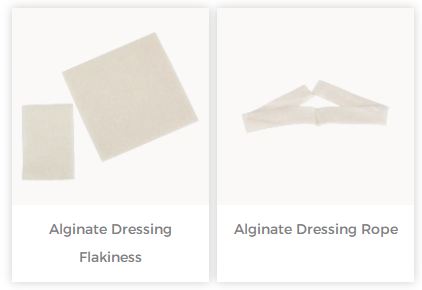Crohn's disease (CD) mainly manifests as discontinuous transmural inflammation of the digestive tract. Although drug treatment is the main treatment at the initial stage, as the disease progresses, 80% of the patients require surgical intervention. Because of the characteristics of the consumptive disease, high surgical risk, many complications, and easy recurrence after the operation, many patients have to undergo ostomy surgery. CD has become one of the most common causes of enterostomy. In addition, due to the heterogeneous disease characteristics of CD, different patients have different disease sites and phenotypes, and each patient may have different complications during the course of the disease.
The following is a case sharing:
the patient was a 37 -year-old male patient who was diagnosed with Crohn's disease on March 15, 2020 and underwent a temporary stoma operation. The normal weight was 120 kg, and the postoperative weight was 90 kg. The ostomy bag was replaced by the nurse within 2 weeks after the operation.During this period, the doctors and nurses did not observe the stoma, which resulted in the separation of the stoma mucosa and skin, ulceration, and severe infection. The patient was in unbearable pain and suffering. The patient found our optimist. At that time, the infection of the stoma was very serious, and nursing was very difficult. After being discharged from the hospital, he was taken care of by his family.
The picture below is the photo taken at that time:

case analysis:
As can be seen from the picture above, in addition to the wound itself, sinus passages and even perforation may appear below. A sinus tract with a stoma is 5-6cm deep. At the same time, there is a small hole on the edge of the stoma mucosa, and there is gas, which can be said to be serious.
solution:
the first step for such wounds must be to debride the wound first. You can first clean the wound with normal saline, then soak it in povidone-iodine disinfectant for 10-20 minutes, and then clean the disinfectant with normal saline. After drying the wound, use alginate dressing to fill it, then apply leak-proof cream, and cover it with an ultra-thin hydrocolloid dressing. Finally, according to the conventional stoma care method, use anti-leakointment and stoma bag, and replace it every 2 days.
Considering that patients are basically bed-rested after discharge, intestinal ulcers are prone to bleeding after sitting in a wheelchair for a long time. It is recommended that the patient goes to the hospital for reexamination. Because his nutritional status is very poor, he is thin and weak, so he drinks Baipre, which is the nutrient solution in the intestines, every day. Nasogastric feeding 3 bottles a day, I feel my body has improved.
May 14:
pus will be produced after each dressing change, and there is no smell. The wound did not widen or deepen. The medicine has been changed every day for the past week. (The pus should be filled with alginate dressing, which becomes a gel after absorbing water.) Although the wound is large, it has improved significantly. On April 15, the patient reported that the wound was 1mm smaller. It is clear. No other abnormalities occurred. The crimping persisted, the color was pink, the ostomy bag did not leak, and the infection did not aggravate visually. Under the premise of protecting the wound, it is recommended to change the dressing once every two days, rinse the wound with normal saline, continue to soak in povidone-iodine disinfectant for debridement, fill every place with alginate dressing, and try not to leave dead space. After that, the wound healed relatively quickly, the granulation quickly crawled, the sinus tract recovered, and the fistula was not obvious. Continue filling care with alginate dressing. Suggestions in life: Eat small meals frequently, eat digested food, move around appropriately, and take precautions against catching a cold.
the patient did not start to gain weight slowly until mid-June. In July, the weight increased from 85 kg to 100 kg. He ate Ansu plus high-protein food. He ate four meals a day, ribs soup, fish, and shrimp, Usually eat fatty meat, tube bone soup, and so on. In September, the stoma retraction operation was performed, and the recovery is good.
sequence for the separation of enterostomy mucosa and skin: Wash the wound with normal saline—Povidone iodine disinfection—Clean again with normal saline and dry— Alginate dressing —Waterproof dressing (film or hydrocolloid dressing) - leak-proof ointment - ostomy bag.
Crohn's disease is a complex chronic inflammatory disease of the digestive tract with many complications, severe symptoms, and many nursing problems, which correspondingly increases the difficulty of nursing work. Therefore, on the basis of routine nursing care, stoma and nutrition care should be strengthened, and infection prevention should be paid attention to, which greatly improved the nutritional status of the patient and laid a solid foundation for the treatment of later diseases.
For more information on Innomed® alginate dressing, refer to the previous articles. If you have customized needs, you are welcome to contact us; we will serve you wholeheartedly.
At Longterm Medical, we transform this data by innovating and developing products that make life easier for those who need loving care.
Editor: kiki Jia
Date: January 20, 2023

 English
English عربى
عربى Español
Español русский
русский 中文简体
中文简体








